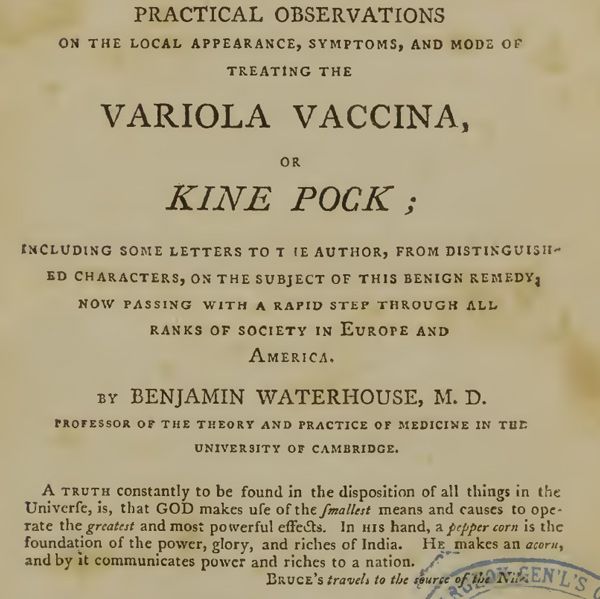In Monticello, President Jefferson receives the latest book on preventing smallpox by Dr. Benjamin Waterhouse. The two had worked to find the best method to preserve living kine pox cultures—one of which Lewis likely employed moving down the Ohio River.
The entire title page reads:
A Prospect of exterminating the Small Pox
PART II,
BEING A CONTINUATION OF A NARRATIVE OF FACTS CONCERNING THE PROGRESS OF THE NEW INOCULATION IN AMERICA;
TOGETHER WITH
PRACTICAL OBSERVATIONS
ON THE LOCAL APPEARANCE, SYMPTOMS, AND MODE OF
TREATING THE
VARIOLA VACCINA,
OR
KINE POCK;
INCLUDING SOME LETTERS TO THE AUTHOR, FROM DISTINGUISH—
ED CHARACTERS, ON THE SUBJECT OF THIS BENIGN REMEDY;
NOW PASSING WITH A RAPID STEP THROUGH ALL
RANKS OF SOCIETY IN EUROPE AND
AMERICA.
BY BENJAMIN WATERHOUSE, M. D.
PROFESSOR OF THE THEORY AND PRACTICE OF MEDICINE IN THE
UNIVERSITY OF CAMBRIDGE.
A TRUTH constantly to be found in the disposition of all things in the Universe, is, that GOD makes use of the smallest means and causes to operate the greatestand most powerful effects. In HIS hand, a pepper cornis the foundation of the power, glory, and riches of India. He makes an acorn and by communicates power and riches to a nation.
BRUCE’s travels to the source of the Nile
CAMBRIDGE,
PRINTED FOR THE AUTHOR, AT THE UNIVERSITY PRESS
BY WILLIAM HILLIARD.
1802.
Published according to act of Congress.[1]Benjamin Waterhouse, A Prospect of Exterminating the Small Pox, Part II (Cambridge: The University Press, 1802), title page.
Preventing Smallpox
Cambridge March 1st. 1803.
Sir
I here transmit for your acceptance, a copy of my Treatise on the Kine Pock, which, though dated Novr. 1802 is just out of the press. The first part contains the history of the progress of this new inoculation in America;
Being aware that this first narrative would probably be referred to, in time to come, I was desirous to give it all the dignity in my power, by recording the patrons of this new discovery & practice. The unreserved applause which some of its most distinguished patrons have received in all the newspapers in this part of the Union, has given us high satisfaction.
With high respect, I am your very humble servt.
Benjn. Waterhouse[2]Benjamin Waterhouse to Thomas Jefferson, Founders Online, National Archives, founders.archives.gov/documents/Jefferson/01-39-02-0523 accessed 15 May 2022. [Original source: The Papers of Thomas … Continue reading
Excerpts from A Prospect of Exterminating the Small Pox, Part II
It is perhaps unnecessary for me to say, that it is found, from the most incontestable experiments,
I. That the kine-pock is not contagious.
II. That it never has been fatal.
III. That it completely prevents the small-pox.
IV. That it conveys no constitutional disease. And
V. That it creates no blemish, or mark, on the human[3]Waterhouse, 28.
If we take on the point of a lancet a drop of that morbid poison, which from its parent is denominated the cow pock virus, and with it slightly puncture, or scratch the scarfskin, we very rarely fail communicating the vaccine disease. If on the punctured part a little red spot appear on the third day, we have reason to believe that vaccination has succeeded.[4]Waterhouse, 92.
Notes
| ↑1 | Benjamin Waterhouse, A Prospect of Exterminating the Small Pox, Part II (Cambridge: The University Press, 1802), title page. |
|---|---|
| ↑2 | Benjamin Waterhouse to Thomas Jefferson, Founders Online, National Archives, founders.archives.gov/documents/Jefferson/01-39-02-0523 accessed 15 May 2022. [Original source: The Papers of Thomas Jefferson, vol. 39, 13 November 1802–3 March 1803, ed. Barbara B. Oberg. Princeton: Princeton University Press, 2012, pp. 615–616.] |
| ↑3 | Waterhouse, 28. |
| ↑4 | Waterhouse, 92. |
Experience the Lewis and Clark Trail
The Lewis and Clark Trail Experience—our sister site at lewisandclark.travel—connects the world to people and places on the Lewis and Clark Trail.
Discover More
- The Lewis and Clark Expedition: Day by Day by Gary E. Moulton (University of Nebraska Press, 2018). The story in prose, 14 May 1804–23 September 1806.
- The Lewis and Clark Journals: An American Epic of Discovery (abridged) by Gary E. Moulton (University of Nebraska Press, 2003). Selected journal excerpts, 14 May 1804–23 September 1806.
- The Lewis and Clark Journals. by Gary E. Moulton (University of Nebraska Press, 1983–2001). The complete story in 13 volumes.


